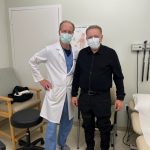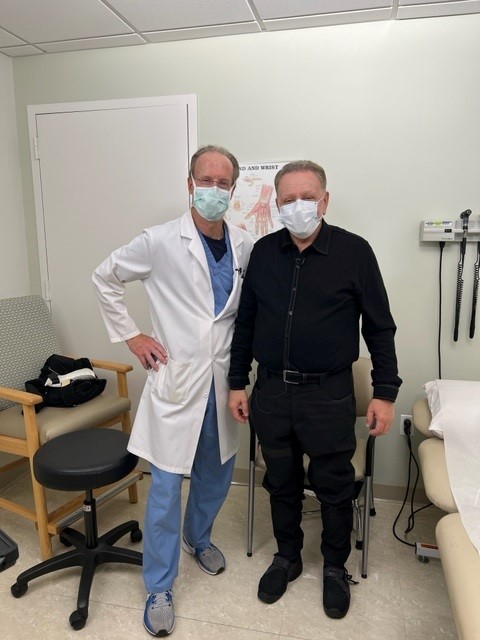It was 2014 when I realized after a round of golf that something was wrong with my wrist. I was age 63. An Atlanta specialized orthopedic practice diagnosed the condition as SLAC, scaphoid lunate advanced collapse. One physician diagnosed it as Stage 1 and a short time later another in the same practice diagnosed it as Stage 4. Something didn't sound right. That physician decided he would fuse all the bones in my hand together. I wouldn't have anymore pain, but that was because I also wouldn't be able to move my wrist. I did not like that so I researched and found that wrists could in fact being replaced by a prosthesis, in an operation known as a total wrist arthroplasty.
I performed further extensive research and reviewed as much information, professional journal articles, etc. as I could and found Dr. Scott Wolfe at HSS and visited him that year. Dr. Wolfe had invented what I thought was the best device but it was only approved for export but had been successfully implanted in the UK by one of two of Dr. Wolfe's co-developers. The device, KinematX, was at that juncture developed as a hemi-arthroplasty device (the part that goes in the forearm) for patients who had sufficient cartilage in their wrist, but was still in development in the US and was to be submitted for FDA approval for patients who needed either the hemi or the total wrist arthroplasty. When I visited Dr. Wolfe. I happened to find his presentation on KinematX and its development on the website of the American Society of Surgery for the Hand (ASSH) before he saw it! So when I had my visit, I really was educated, or so I thought. When Dr. Wolfe told me the story of KinematX, I told him I would wait.
Then, I continued to research and found even more devices. I corresponded by email occasionally about things I discovered and about the FDA approval progress. I knew from everything I read that Dr. Wolfe was the leading wrist orthopedist in the world. There's simply no question about it. He started the process of developing KinematX 30 years ago with Dr. Trey Crisco at Brown University, where even the math to develop the bio-mechanical engineering to enable KinematX to let the wrist to move naturally (the dart thrower's motion) had to be developed.
I knew in 2014 I was going to wait. However, I didn't think the wait would be 7 years! I had a google alert to see if something better than KinematX came along. Nothing did. I think the orthopedic world just knew that they couldn't beat KinematX for its technical sophistication and practicality. Closer to the end of my wait, I practically had the FDA website for device approvals "on speed dial" and anxiously scanned each month's approvals the day they were released. Finally, there it was. It was game on. We scheduled the surgery. I was to have the honor of being the first on the planet to receive the KinematX as a total wrist arthroplasty I had and still have so much faith in Dr. Wolfe and HSS. I have 'faith of the heart', like the Rod Stewart song. I found out the long and prominent history of HSS and learned my cousin's husband, who live in New York City, not too far away it turns out, used HSS, too.
I did not know exactly what to expect the day of surgery. During the short walk from the prep room to the operating room I was happily thinking to myself "bad wrist walking", similar to the line from the Sean Penn movie. When those operating room doors opened, it seemed like there were so many gowned medical professionals and I knew I was in 'good hands'. When I awoke in the recovery room I had a great nurse who it turns out has a father who is my Manhattan cousin's ophthalmologist.
I had a big cast on my wrist and forearm and had no pain since the nerve block was designed to last 24 hours. I was fortunate to be able to stay in Manhattan with my cousin (and because of COVID-19 restrictions at the time turned out to be 3 full weeks which would not be the case now). When the nerve block wore off, I managed the pain mostly with acetaminophen and only had to take very, very few and minimal doses of the pain pills that had been prescribed. Ten days later the cast came off and HSS's CHT (certified hand therapist) made me a splint that my Atlanta CHT thought was so good she took a photo of it.
I began wrist therapy when I returned to Atlanta. I visited Dr. Wolfe after 90 days and everything looked good. After about 5 months of twice weekly visits my therapist said I had successfully completed the course of therapy but she was so good I decided to extend it a month in anticipation of my 6 month visit with Dr. Wolfe. He was pleased and I was pleased. I did have one issue where a part of my hand was sore. My CHT, Rachel, asked me if I was resting my hand on anything when I typed. I said so, but then caught myself doing just that. It turned out to have been caused by a bad keyboard wrist rest. I wouldn’t have caught that if it weren’t for Rachel’s insisting I check and photograph the keyboard and setup. Many years ago I found that I couldn't type with the keyboard slanted up and away from me, before I realized that my wrist had deteriorated. I then learned the correct ergonomic keyboard position for typing was a below desk keyboard tilted slightly down and away from the wrists. While that keyboard had a foam wrist rest, it was not a soft foam (I now have memory foam), had sharp edges and over time had literally turned hard as a rock. The edge was pressing on just the wrong bone in the wrist in just the exact way to cause the problem. I shared this with Dr. Wolfe in before and after photos and he said he will be advising other patients. I was so glad to help.
I learned early on that wrist replacements, unlike hip, knee, shoulder and ankle replacements did not have the same longevity. The wrist looks simple and even I thought that shouldn't be the case when looking at a model. There are a limited number of bones in the wrist itself, but they are odd shaped and embedded in cartilage and move in truly kinematic, twisty rotational ways. I once described it to Dr. Wolfe as "gummy bears assembled like a Rubik's Cube. What I then learned is that on top of this the human hand is made up of the wrist, palm, and fingers and consists of 27 bones, 27 joints, 34 muscles, over 100 ligaments and tendons. It's complicated.
During my recovery, I followed all of the protocols and in addition to therapy did hand exercises at home. In addition, I used common sense in not overdoing it. At my six month review, Dr. Wolfe was able to 'release' me. I am now pain free and can do a lot of things around the house that I had to stop doing. Some light use of my tools, washing and waxing the car and a lot of just everyday chores that had become painful or difficult, like pouring a gallon of anything. I like to work with my hands and now do my own art and sculptures. I got the go ahead to do some golf "chipping", but a full round of golf will have to wait. Fine with me. I don't feel like I'm limited anymore but I also don't want to repeat the mistake I made when in high school that created the need for a wrist replacement in the first place.
From my first visit with Dr. Wolfe to maybe a month before my surgery Dr. Wolfe asked me if I had ever broken my wrist. I did not. But after wracking my brain over and over again I did remember what happened. In high school I played so much golf (in Florida where I grew up), I finally remembered I had hit a golf shot from a tree root. I bragged to my friends I could pick the ball off clean. I didn't. My hand stung. But that went away. My x-rays later in life did not show any healed break, but it could have been a hairline fracture or a ligament that started a 45-year deterioration in my wrist that ended with bone on bone pain. Back then, there were no CT scans or MRI's.
Now, I'm pleased as punch. Only evolution and a higher power can create our wrist. Short of growing another one like an octopus can grow a tentacle, I now have 50% movement in my wrist, more than enough to consider it functional, which is 40%. But that's 100% more pain free movement than I had.
It is my hope that KinematX wrist replacements become commonplace in the future for osteoarthritis and SLAC and similar wrist issues, not just as a last resort for rheumatoid arthritis. I hope whenever that happens in the future, I’m able to put my two cents in and appear alongside Dr. Wolfe and the orthopedic hand and wrist world to make that a reality.
I may not be on the golf course yet, but I am truly back in the swing.






